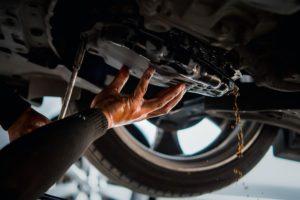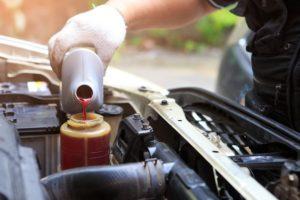Keeping your vehicle’s transmission in good shape is necessary for it to operate and properly move. Its job is to take power from the engine and direct it to the wheels of your driving mechanism. It needs to continually be lubricated. So, what do you do if you experience a transmission slipping after fluid change?
Contents
What Does a Transmission Do?

A gearbox attached to the transmission allows drivers to switch gears. When they are changed, the rotating power and speed in the engine get converted based on whatever demands are required.
They contain several moving components and parts that need lubrication by using transmission fluid. It allows the parts to run smoothly and cools them down if they overheat.
As time passes, transmission fluid may become old and begin to have a build-up of debris. By changing your transmission fluid every 50,000-100,000 miles, depending on your vehicle, you ensure the fluid is fresh and eliminate the potential for issues while driving.
Benefits of Regularly Changing Transmission Fluid

- Improved Fuel Economy. Fresh fluid resists oxidation better and meets lubrication/viscosity standards easier. This generates better fuel economy for the vehicle.
- Better Gear Shifting. When you check the transmission fluid regularly and service the car, the gears move smoother. Over time, it protects the gearbox, which may end up saving you the cost of an expensive repair.
- Lower Costs. Changing your transmission fluid saves money and time in labor. Costs can be further reduced by utilizing a synthetic transmission fluid. This fluid has a longer lifespan and other features which make it last longer.
- Extended Life of the Transmission. Well-maintained cars receive regular top-offs of transmission fluid. They also have a complete flush of the system and replenishment when required. Routine maintenance helps keep the transmission in proper working order and extends the life of the vehicle.
- Reduces Rust. Transmissions can easily experience corrosion and rust. Chemicals, moisture, and other factors contribute to damages to the transmission. Changing the transmission fluid regularly reduces and prevents problems from arising.
What Causes Transmission Issues After a Fluid Change?
Once the transmission fluid is changed, ideally, you should not have issues maintaining driving speed or shifting gears. It should be seamless. You shouldn’t hear unusual noises coming from the car or experience anything strange.
Yet, there are instances when a driver will feel something is wrong with their vehicle or hear noises from the transmission shortly after changing the fluid. The person may wonder why this happens when the fluid is supposed to prevent it.
There are two common causes of this occurring once the fluid has been changed. They include varnish deposits and putting in the wrong type of transmission fluid.
Varnish Deposits
Old or burnt transmission fluid may show signs of discoloration and cause varnish deposits to build up. The deposits usually float around old fluid and tend not to build up anywhere else if you use the same fluid.
Once the old fluid is changed with the newer fluid, deposits become washed away. Then, it turns into sludge that sticks to the filter of the transmission system. It prevents fluid from flowing through the vehicle’s transmission resulting in strange noises.
If this is the case, you will need to flush the transmission before adding new fluid. It is the best method to ensure no pathways become clogged within the transmission.
Using the Wrong Type of Fluid
Experts indicate that it is not wise to use petroleum-based traditional transmission fluid. This type of fluid tends to leave a lot of deposits behind causing issues with your transmission. Once they build up on the filter and restrict transmission fluid from properly flowing, it causes the components of the transmission to heat and generates more friction instead of lubrication.
When this happens, you will hear clunking and other unusual noises coming from your vehicle. To remedy this, synthetic transmission fluids are available to ensure the components remain properly lubricated and allow the gears to smoothly shift. To find this type of fluid, check for something that reads, “trans medic or transmission fix”.
The Best Types of Transmission Fluid
The best type will always depend on your vehicle, so please consult your owners manual before purchasing to ensure that you put the correct fluid into your car.
ACDelco Dexron VI Synthetic ATF
ACDelco makes a synthetic automatic transmission fluid that is backward compatible. It will work with a variety of automatic transmissions. However, you will need to consult with your manual to make sure it is the best for your vehicle before usage.
Pros:
- Designed for resistance to friction, increased viscosity, and foam control.
- Will allow for improvements in shifting gears and extends the life of your transmission.
- Created for anti-wear protection/shear stability
Cons:
- Bottle doesn’t reference what vehicles it is compatible with
Castrol Transmax Dex
This product has enhanced friction durability making it a popular choice when looking for almost universal transmission fluid. It works very well with transmission environments and power steering.
Pros:
- Can be used with different types of vehicles requiring Mercon and Dexron
- Comes in a large-sized bottle
- High-temperature protection when highway and city driving
- Oxidation resistance
Cons:
- Label states it is compatible with only domestic cars when this isn’t true. It works with both domestic and imports if the vehicle takes this type of Dexron or Mercon.
- May cause some vehicles to become jerky
Red Line GL-4 Manual Transmission Lubricant
Red Line is known to deliver results when it comes to your transmission. It has a solid history of superior performance.
Pros:
- Not as slippery
- Low formulation of sulfur and optimal heat stability
- Works well in high-performance atmospheres
- Works in older cars and may fix issues with the third gear
Cons:
- May act up in cold temperatures
- Difficulty shifting until gearbox warms up
Other Reasons
If the above solutions don’t solve your problem, other reasons may be:
- Defective solenoid- Check and replace solenoid
- Worn out transmission bands- Adjust or replace the band
- Clutch wear may cause automatic and manual transmission slippage- Replace your clutch
- Transmission gears wearing out- Either replace the gears or the transmission
- Torque converter issues- Check the torque converter and replace it if necessary
- Transmission fluid leak- Check fluid levels. Look underneath your vehicle around the pan or driveway for leaks. Seal the leak.
To prevent your transmission from slipping, it is wise to do regular maintenance. A slipping transmission is usually caused by worn-out fluid. If, after replacing the fluid, your transmission is still slipping, it may be due to varnish deposits, or more likely, using the wrong type of transmission fluid.
Before topping up or changing your transmission fluid, consult with the manual for what type you should be using to save you both time and money. If, after doing these steps, the transmission still slips, you may want to consider that there are further things that may require investigation.




2 thoughts on “Transmission Slipping After Fluid Change – What to do Next”
Comments are closed.